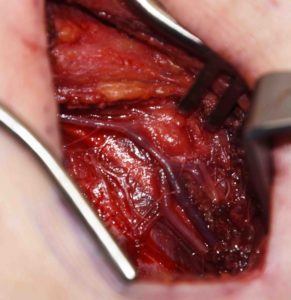Rib removal can be done for a variety of aesthetic and medical purposes. The most common aesthetic reason is for horizontal waistline narrowing with the subtotal resection of the truly free floating ribs. (#s 11 and 12) Through a small obliquely oriented skin incision on the back the midportion of the ribs are identified just lateral to the erector spine muscle and cut. From that position the rib is then dissected out to its cartilaginous tip and removed.
One of the keys to rib dissection is that it is done in a subperiosteal plane. The periosteum is tightly wrapped in a circumferential manner around the bony rib. Getting under this tissue layer allows for the smoothest and cleanest plane of dissection but also preserves all surrounding structures. This is most relevant to the neurovascular bundle that sits in a groove on the inferior side of the rib. Elevating and preserving the artery and vein makes not only for less intraoperative bleeding but prevents inadvertent nerve injury/transection and the potential for chronic postoperative rib pain.

Rib removal is often associated with a destructive and very invasive surgery, undoubtably influenced by thoracic surgery which has a different intent for its performance. From an aesthetic stand point it is important that rib removal be doing through small incisions and minimize any risk for chronic postoperative pain from intercostal nerve injuries.
Dr. Barry Eppley
Indianapolis, Indiana


